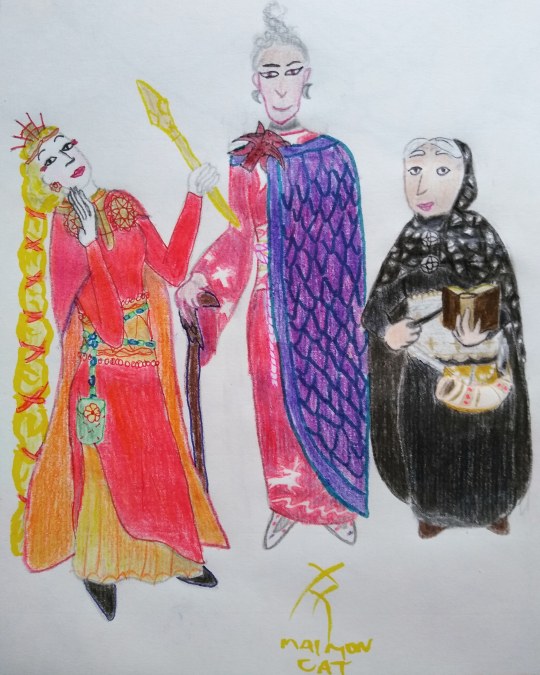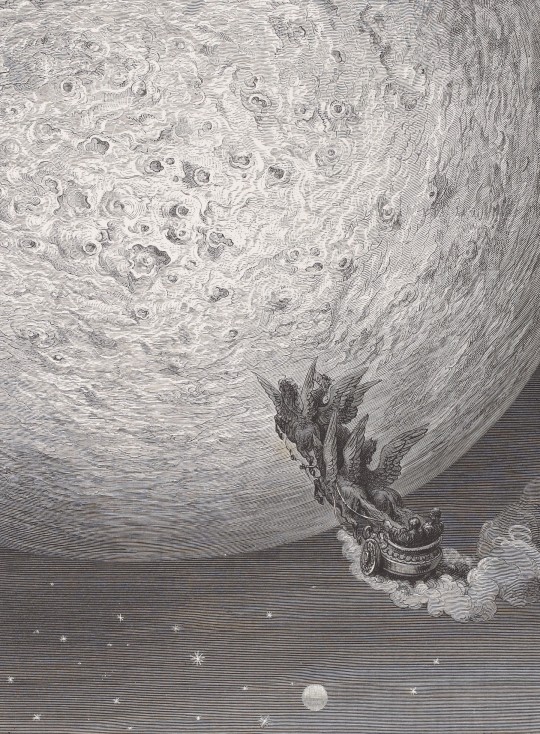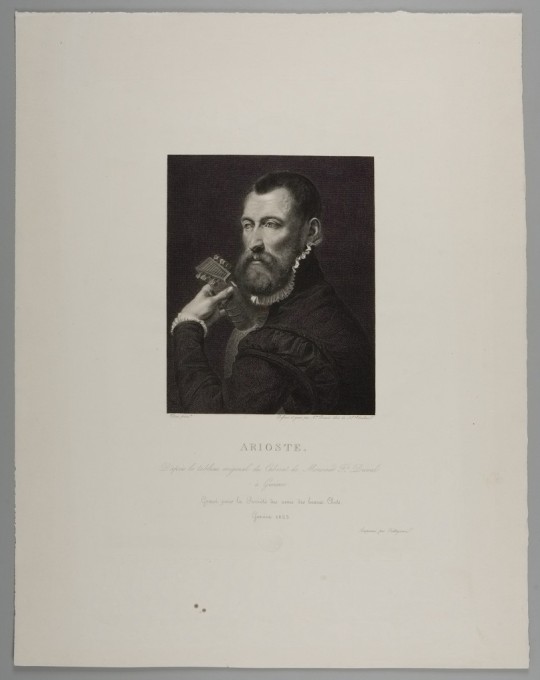#arioste
Explore tagged Tumblr posts
Text

Anselm Feuerbach (German, 1829-1880) Garten des Ariost, 1863 Schack Collection, Munich
#Anselm Feuerbach#german art#german#germany#garten des ariost#1863#1800s#art#fine art#european art#classical art#europe#european#fine arts#oil painting#europa#mediterranean#dante
15 notes
·
View notes
Text

Portrait of the poet Ludovico Arioste (1474-1533), after Titian. 18th C.
0 notes
Text

Poco fa ho visto la produzione del Glyndebourne di Alcina, con la regia di Francesco Micheli. È una produzione fantastica, che si può noleggiare a 11 euro. Ho pensato di postare qui un disegno di due anni fa delle sorelle
Morgana, sebbene non appare nel Furioso, ha un ruolo importante nell'Innamorato di Boiardo, dove è uno degli antagonisti soprannaturali principali del romanzo. Assume aspetti di quasi ogni fata dei racconti bretoni (l'altro mondo subacqueo, l'amante rapito, il cervo bianco dalle corna d'oro) mescolati alla Fortuna personificata dell'immaginario italiano: infatti porta i capelli corti col ciuffo, e Orlando deve rincorrerla e acciuffarla per raggiungere i propri scopi. Come nel ciclo bretone, è un personaggio ambiguo, non buono, ma con aspetti anche umani. Nel folklore italiano è diventata la fata malvagia per eccellenza, e al Sud si dice che viva su un palazzo fluttuante sullo Stretto di Messina. In Sicilia è anche conosciuta come la madre delle fate e delle Donne di Fuora.Alcina appare in entrambi i Romanzi cavallereschi, ed è una maga ingannatrice, che incanta gli eroi Astolfo e Ruggiero per tenerseli sulla sua isola, finchè non se ne annoia e li muta in piante, rocce ed animali. Quando peró Ruggero fugge, grazie all'aiuto della strega Melissa, l'incantevole fata conosce per la prima volta l'abbandono e desidera morire, cosa per lei impossibile. Anche lei trovó gran successo nelle leggende, venendo identificata con la Regina Sibilla, la sovrana delle fate. Da lei Händel trasse la sua omonima operaLogistilla è stata inventata da Ariosto, e le vicende che la riguardano sono un'allegoria per la difficoltà di evitare i piaceri e i vizi, ricompensata però dalla vera gioia della Ragione e Virtù (il suo nome infatti deriva dal greco λόγος, "parola", "ragionamento"): Ruggero per raggiungere il suo bellissimo palazzo che rispecchia i pensieri della gente, pieno di oggetti meccanici o miracoloso, deve prima attraversare l'ardua strada piena di ostacoli sull'isola delle fate, venendo continuamente tentato dalle damigelle di Alcina. Forse è proprio per questa sua natura allegorica, che Logistilla è stata perlopiù dimenticata. Appare solamente nella fiaba della "Regina Marmotta", raccolta da Gherardo Nerucci, e aggiunta alle "Fiabe italiane" di Calvino. Lì il suo nome diventa Lugistella, e così, dato che Alcina nel Furiosa è paragonata al Sole, ho voluto dare alle tre fate un tema astrale.
Hab vor kurzem die fenomenale Glyndebourne Produktion von Alcina geschaut, also wollte ich mal hier dieses alte Bild von den Mädels posten.
Morgana taucht zwar im Furioso nicht auf, spiel aber im Innamorato eine wichtige Rolle als magische Shurkin. Boiardo gab ihr sowohl Eigenschaften der Bretonischen Feen (unterwasser Zauberwelt, entführter Liebhaber, weißer Hirsch mit goldenem Geweih) als auch der Italienischen Glücksvorstellung: sie trägt nämlich ihr Haar kurz und Roland muss sie verfolgen und am Schopf packen, um zu siegen. Morgana wurde zu der bösen Fee schlechthin im Italienischen Glauben und man sagt, sie lebe auf einem schwebenden Achloss auf der Straße von Messina. In Sizilien glaubt man auch, sie sei die Mutter der Feen und Donne di Fora.Alcina kommt in beiden Ritterepen vor, und ist eine tückische Zauberin, die die Ritter Astolfo und Ruggero bezaubert und auf ihrer Insel fest hält. Danach verwandelt sie sie aus Langeweile in Pflanzen, Steine oder Tiere. Doch als Ruggero dank der Hexe Melissa entkommt, spürt sie zum ersten Mal den Schmerz des Verlassen Werden und wünscht sich den unerreichbar en Tod. Auch sie spielt später eine Rolle in der Italienischen Folklore, wo sie mit der Sibylle, der Feenkönigin gleichgestellt wird. Händel basierte auf Alcina seine gleichnamige Oper.Logistilla wurde von Ariost erfunden und ihre Geschichte ist eine Allegorie für das schwere Überwinden von Genuss und Sünde um Verstand und Tugend zu erreichen (ihr Name selbst kommt vom griechischen λόγος, "Wort", "Gedanken"). Um iheen Fabelhaften Palast, voller technischen und magishen Wundern, muss Ruggero einen weiten schweren Weg überwinden, und den Versuchungen der Alcina wiederstehen. Eben wegen ihrer allegorischen Natur hat sie keinen Platz im Volksglauben gefunden. Nur im Märchen der "Murmeltierkönigin" von Gherardo Nerucci und Italo Calvino gesammelt, taucht sie als Lugistella auf. Darum wollte ich im Bild die Feen mit Himmelskörpern verbinden.
Recentoy watched the amazing Glyndebourne production of Händel's Alcina, so I wanted to post this old picture I had done of the girls.
While not appearing in the Furioso, Morgana plays an important role as Supernatural villain in the Innamorato. Boiardo gave her both elements of Breton fairies (underwater Other World, kidnapped lover, white deer with golden antlers) and of the Italian depiction of Fortune: she has short hair and Roland needs to chase her and grab her by her forelock to succeed. She also found much success in Italian folklore, where she became the go-to evil fairy of Folktales. In the South, she's believed to live on a floating palace on the Strait of Messina and to be the Mother of fairies and Donne di Fora.Alcina appears in both chivalry poems, and is a cunning sorceress who lures the knights Astolfo and Roger on her island and traps them there, before turning them into plants, rocks and animals out of boredom. But when Roger escapes thanks to the witch Melissa, the beautiful Fairy discovers the pain of abandonment and loss. She too found a place in Italian legends, where she was identified with the Sibyll Queen, ruler of the fairies. Händel based his opera "Alcina" on this facinating figure.Logistilla was invented by Ariosto, and her story is an allegory about the hardships at overcomming pleasures and vices in pursuit of reason and virtue (her name comes from the greek λόγος, "word", "reasoning"). Before reaching her truth-revealing castle, full of technological and magical wonders, Roger must go through the dangers of the fairy island, while resisting Alcina's temptations. It's probably because of her allegorical nature that Logistilla barely had an impact on the folk tradition. She only appears in the tale of "the Groundhog Queen", collected by Gherardo Nerucci and Italo Calvino, under the name Lugistella. I tried to use an astral theme with these characters, since Alcina is compared to the Sun too.
#my art#my artwork#Alcina#Alcina händel#orlando furioso#orlando innamorato#italian literature#Italian folklore#Regina sibilla#Sibilla appenninica#fata morgana#morgan le fay#fairy queen#faerie#Logistilla#Lugistella#Sole luna stelle#Sonne Mond und Sterne#sun moon and stars#old art
4 notes
·
View notes
Photo

Roland furieux : poème héroïque - Arioste, traduit par A. J. du Pays et illustré par Gustave Doré - 1879 - via Gallica
698 notes
·
View notes
Text
21 notes
·
View notes
Photo

Arioste, Charles Bouvier, 1823, Harvard Art Museums: Prints
Harvard Art Museums/Fogg Museum, Gift of William Gray from the collection of Francis Calley Gray
https://www.harvardartmuseums.org/collections/object/275906
2 notes
·
View notes
Photo

Félix Vallotton - ‘Roger délivrant Angélique' (Ruggero befreit Angelica), 1907. (Ariost, Orlando Furioso, X).
1 note
·
View note
Text
Dedication section from Rapsodies
Translators: Joseph Carter, Olchar Lindsann The whole translation is online free here, and should really be checked out, if only for the footnotes! Sharing this bit because Gautier references it in History of Romanticism, specifically the bit about Joseph Bouchardy :
Assuredly, the bourgeoisie will not be at all alarmed by the names dedicated that it will meet in this volume; simply, they are all young folk, like me; of heart and of courage, with whom I grew, how I love them all! It is they who make disappear for me the platitude of this life; they are all frank friends , all comrades of our camaraderie, tight camaraderie, not that of Mr. Henri Delatouche: ours he would never understand at all. Feared I not having an air of paragoning our small names to those larger, I would say that ours, ours is that of the Titien and of the Arioste, that of Molière and of Mignard. It is to you above all, companions, that I give this book! It was made among you, you may claim authorship. It is to you, Jehan Duseigneur, the sculptor, beautiful and good of heart, secure and courageous work, nevertheless ingenuous as a girl. Courage! your place would be beautiful: France for the frst time would have a French statuary.—To you, Napoléon Thom, the painter, air, frankness, soldierly handshake. Courage! you are in an atmosphere of genius. —To you, good Gérard: when then, the customs officers of literature, will they let arrive to the public committee the works, so well received from their small committees. — To you, Vigneron, who have my deep friendship, you, who prove to the coward that which can be done by perseverance; if you have carried the mortarboard, Jamerai Duval has been the drover. — To you, Joseph Bouchardy, the engraver, heart of saltpetre! — To you, Théophile Gautier. — To you, Alphonse Brot! — To you, Augustus Mac-keat! — To you, Vabre! to you, Léon! to you, O'Neddy, etc.; to you all! who I love.
8 notes
·
View notes
Text
Relents furieux

Débauches en ébauches
Débâcle – de clic en claques,
Clameurs que réclame
Le comble du décombres,
J’ai le bleu trouble de la vie
Sans l’anémie du plus mort.
Je coupe les ponts en or
Sur lesquels je m’étais assis,
Je récuse la réception
Du message de déception.
Parti malhabile sans adresse,
Pardessus plein la tête,
Impair hâtif fait subjonctif,
Je danse entre les larmes de la pluie.
Rébus non conforme
D’un rebut protéiforme,
Fallait-il qu’elles s’abstinssent
En traversières bulles à flûtes,
Que mitonnent, gloutonnes,
Les gouttes que goûte chair brute ?
La nuit porte conseil
Que le jour ne suit
Faute d’oubli.
Tout se meurt
Entre les battements du cœur
Qui ne compte que sur vous,
Vide et Tout,
Pour le fendre en deux
Du trait du dieu
Des amoraux
Kiss-biscotte
Sur les big-bangs plus bibliques
Aux « furieux relents » satiriques
Du divin Arioste.
Choix des choix
Qui trop souvent déchoit,
L’amour se montre à mon doigté.
L’amour ce monstre sommé,
Ce met - ce «mens» sommet,
Brûle en poèmes
D’un feu suprême
Plus nu que lui-même.
AD Poignets d’amour
15 notes
·
View notes
Video
tumblr
Arioste-IPRAY (prod. 4URA)
0 notes
Note
That's actually very historically accurate. In Renesas Italy small boobs were extremely attractive and very often women tried to make their breasts smaller.
Pietro Bembo in his treatise dedicated to the nature of love - Gli Asolani (1505) described perfect breasts like this: "two round, firm, unripe little breasts"
Ludovico Ariost described ideal boobs as:
"The small rounded breasts were like beads of milk newly pressed from a reed. They were so set apart, they resembled two little hillocks and between them a pleasant shady dell in the season when winter snow still lies in the hollows."
Perfect boobs were supposed to be round, firm and well parted from one anothe.
Pietro Bairo in his medical book- Secreti Medicinali has an entire fucking chapter titled “Of those things that forbid the breasts from growing, and that straighten them when they hang down uglily."
Yes. Renesas Italians wrote a lot about perfect boobs. They really liked boobs. Still do.
So yeah, Ezio probably would dig small breasts.
"Ok, so I noted in the Brotherhood book that Ezio comments how he likes that Caterina's breasts are neither small nor large and he's always struck me as a tits guy so I'm going to say he likes humbly sized breasts the most."
WHAT
OK FUCK I MISREMEMBERED IT - EZIO LIKES SMALL BREASTS. It's been like 3/4 years since I've read this book tho keeping in mind 😭
From page 55 of Brotherhood:
"Nature had indeed been kind to her. Her slender yet curvaceous body, with its narrow hips, broad shoulders and small but perfect breasts"
#assassin's creed#shitpost#so many assassins#gaming#ezio auditore da firenze#ezio auditore imagine#ezio assassins creed#ezio auditore#renesans#italy
81 notes
·
View notes
Text
https://youtu.be/MKICoIn69QQ #arioste #stay #svs #sinkorswim #blackhistorymonth #blackexcellence #ripkobe
youtube
1 note
·
View note
Link
Das Deutsche Romantik Museum in Frankfurt am Main eröffnet im September 2021 im Großen Hirschgraben. und damit in direkter Nachbarschaft zum Goethehaus (Goethes Geburtshaus).
Goethe wird mit Klassik verbunden. Von Goethe soll der Ausspruch stammen: „Das Klassische nenne ich das Gesunde und das Romantische das Kranke“.
Diese örtliche Synopse zwischen Klassik und Romantik in der Person von Goethe wird in einem Beitrag der Goethe Gesellschaft Erfurt e.V. auszugsweise wie folgt dargelegt:
“Immerhin nennt er auch Texte und Autoren, die er nicht in Bausch und Bogen verurteilt, obwohl auch sie „romantisch“ sind. Ariost ist der Verfasser des „Orlando furioso“, deutsch „Der rasende Roland“. Nicht zu vergessen: Wielands im ironisch gebrochenen Stil gehaltenes Zaubermärchen „Oberon“ wurde unter Goethes Regie am Weimarer Hoftheater als Oper aufgeführt. Trotz einiger Missbilligung („Geschmack“ wird vermisst), hat Goethe das Nibelungenlied zumindest zeitweise geschätzt und sich intensiv mit ihm beschäftigt. Es fehlt ihm dort zugleich eine humane Projektion. Diese mittelalterliche Dichtung enthalte zwar starke Charaktere, jedoch keine kultivierte, ausgebildete Menschlichkeit; kurz nichts Musterhaftes, Vorbildliches. Da müsse man immer zu den alten Griechen zurückgehen. Und was die zeitgenössische Literatur angeht: Hier erweist sich Goethe als übermächtige Autorität gegenüber den „Jungen“, die er ablehnt oder mehr oder weniger milde kritisiert – und die gegen ihn aufmucken. Der Aufstand der „Jungen“ gegen die „Alten“ hat dabei immer eine individualpsychologische sowie eine kulturhistorische Dimension. Dabei pflegte Goethe Ende des 18. und Anfang des 19. Jahrhunderts einen durchaus guten Umgang mit der jungen Generation; es fand ein lebhafter Austausch mit den Schlegels, Schelling, Tieck, Novalis und anderen statt. Und auch umgekehrt. Dennoch kam es zur Entfremdung. Warum? Die Neuorientierung und die Bekämpfung des „Alten“ verbanden sich mit einer Tendenz, die sich immer mehr auswuchs, nämlich die Tendenz, den Wert der eigenen Vergangenheit immer stärker hervorzuheben und ihre Qualität zu behaupten. Diese Tendenz mündete anfangs des 19. Jahrhunderts in den deutschen Kleinstaaten immer mehr in national-patriotische Bestrebungen ein, die mit einer völlig unhistorischen und somit falschen Mittelalterverehrung einher gingen. Diese Tendenz musste Goethes Widerstand, geradezu Abscheu hervorrufen. Er wendet sich gegen das Postulat einer glanzvollen deutschen Vergangenheit, die sich nicht hinter den Griechen oder Römern verstecken muss. Angesichts der gegenwärtigen Zersplitterung wächst die deutsche Einheitssehnsucht an; man glaubt, mit dem Heiligen Römischen Reich Deutscher Nation schon einmal ein einheitliches Deutschland gehabt zu haben. Insofern ist die Wiederbelebung und zugleich Glorifizierung der mittelalterlichen Literatur nicht verwunderlich. Die Auflehnung gegen Napoleon, die in den Befreiungskriegen endete, sah Goethe skeptisch, weil er zum einen einer nationalen Bewegung misstraute, zum anderen kriegerische Auseinandersetzungen als barbarisch ansah. „Alle Freiheitsapostel, sie waren mir immer zuwider Willkür suchte doch nur jeder am Ende für sich.“ (Venezianische Epigramme) Im Zusammenhang mit der Betonung des Deutschen als etwas Eigenem steht die romantische Bevorzugung des Volkshaften und Volkstümlichen, die sich in Sammlungen von Märchen (Brüder Grimm) und Volksliedern (Des Knaben Wunderhorn) niederschlug. Hatten Goethe, Herder und andere noch selbst in ihrer Jugend Volkslieder gesammelt und ihnen einen ursprünglichen Zauber entdeckt, so distanzieren sie sich jetzt von den romantischen Produktionen, die ihnen übertrieben und affektiert vorkommen und sich mehr und mehr in den Dienst nationalistischer Ideen stellten. Eine weitere Ursache für die Entfremdung zwischen Goethe und den Romantikern ist auch in deren mystisch-katholisierenden Bestrebungen zu sehen. Diese standen durchaus in Zusammenhang mit der genannten politischen Idee.”
Ein Besuch sowohl des Romantk Museums als auch des Goethehauses sind lohnenswert.
0 notes
Photo

Roland furieux : poème héroïque - Arioste, traduit par A. J. du Pays et illustré par Gustave Doré - 1879 - via Gallica
241 notes
·
View notes
Link
(2014)Lock To The Box (prod. by C.Winston) by Arioste on #SoundCloud
0 notes
Text

#Barye
Angélique et Roger montés sur l'hippogriffe.
#Arioste #Louvre
0 notes